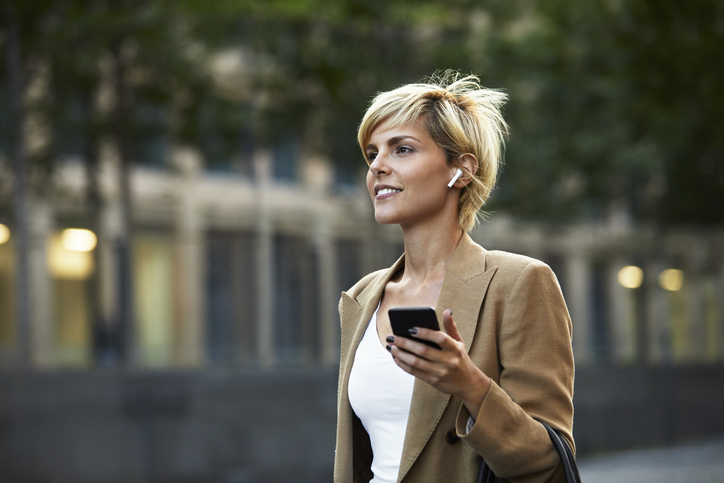Why pyjamas are not appropriate for the office – but relaxed workwear is
COVID, cost of living and a shift towards more sustainable fashion have changed the norms around appropriate workwear
The past few years have seen a radical shift in what many would consider appropriate workwear. After months working from home, office workers have adapted to a hybrid model defined by ‘anchor days’ and flexible working hours. For International Women’s Day, stylist and sustainable fashion advocate Madeleine Park has partnered with Dress for Success, a not-for-profit organisation designed to empower women to gain financial independence by enabling them to face the job market with confidence. Here, Ms Park addresses the challenges of dressing for the new workplace amid cost of living pressures and hybrid work environments.
What is appropriate office wear in a hybrid workplace? How did COVID change what we wear to work?
Anything that says you’re ready for work (i.e. not your pyjamas!) is appropriate, but COVID certainly softened and eased the rules on what’s acceptable. People want a level of comfort not only in what they wear but how they interact with others and this is interfacing with how things are being designed. So whilst suiting has had a moment in fashion for some time now, it’s a deconstructed and softer version of the traditional suit. The modern suit is often seen in fashion-forward colours and in relaxed and oversized fits, carrying the ideas of comfort, ease and adaptability. There is also a trend towards the high-low. So, mixing high-impact items with low-key staples and comfort pieces. An example of this could be a very fashion-forward pink suit with pleated wide-legged pants and an oversized blazer paired back with sneakers, cotton t-shirt and a cross-body bag but this is subverted into a weekend look. Once this suit is deconstructed, the pants on their own offer a lovely sophisticated silhouette that can be paired back to a more traditional fitted business shirt providing a classic silhouette more appropriate for corporate environments.
How are we shopping for workwear now when more people are working from home at least part of the week?
From a consumer perspective, individuals are requiring more adaptability in their wardrobes as well as trying to understand their wardrobes in more sustainable ways. Their clothes need to be chic while driving more functionality across different environments, and as things get tighter financially, this will continue as individuals seek maximum cost per wear out of their garments. So, those pieces that look smart but are comfortable and can translate across different contexts e.g collared t-shirts, a knit midi skirt or tailored pants in natural fibres such as linen, or silk. Consumers are also shifting towards repurposed pieces and investment pieces so there is more longevity to their wardrobes.

Women are now being encouraged to be more assertive in business environments, whether that’s asking for a promotion or getting their point across in meetings. How can you dress for that kind of success?
You only get one chance to make a first impression so it is important to present yourself in a way that is contextually appropriate, resonates with your audience but offers an insight into who you are. While that can feel like a lot of pressure on one outfit, finding that look that makes you feel assertive, is a great way to enter into a confident mindset. Combining that confidence with a sense of self is a very individual thing, but you can fall back on some straightforward styling principles to guide your look. For example, choosing shapes and silhouettes that provide a stronger presence, finding your look in a colour that suits you but in a shade that makes impact and, lastly, accessories – whether it’s the right shoe height, a piece of jewellery that shines a light to who you are or a belt or scarf that adds interest to an otherwise straightforward suit – accessories are a great way to add individuality and lift your look.
Is it possible for women to look professional and feel comfortable in the workplace?
Absolutely! As there is a shift in the fashion industry to design with purpose, we are seeing more and more styles that are adaptable to various environments. As a result, more traditional workwear pieces are being produced in softer, more free-flowing fabrics and in more relaxed silhouettes. Not only is this a more modern way to conceive of workwear, considering the various hybrid work environments a lot of people are operating in, but generally, this translates to looks that offer style and comfort whilst having multiple purposes.
Does the ‘dress for the job you want, not the one you have’ rule still have relevance?
You can think about using your wardrobe as one of the tools in your kit to give you impact. However, as we see more inclusivity across job roles and changing work environments, the rules around dressing for the job you want have changed. Just take the example of Melanie Perkins, the CEO of Canva and billionaire – she has broken the mould in so many ways, not only with a female-founded start-up but she presents as approachable and relatively casual and is fairly vocal about anti-materialist sentiments. So we are seeing a shift in the expectations of appearance and relying more on a focus of an entrepreneurial spirit. Across the board, that sense of entrepreneurialism is associated with more casual looks that wouldn’t have traditionally been associated with negotiating multi-million dollar deals.
Are there different rules around work wear for women and men? What are they?
There are definitely still environments that lend themselves to more traditional gender rules for corporate dressing like a suit and tie for men, blouse, skirt and blazer for women, however these protocols are specific to the individual workplace. As concepts of gender become less polarised and we embrace more size inclusivity, the way fashion is constructed, and trends are evolving, we see more styles designed to fit any body shape. The world is changing so whilst this sentiment might not be as overt in more traditional environments, there are definitely signs that what men and women wear to work is not necessarily defined by gender.
Is it still worthwhile for men to invest in a suit? What about investment clothing for women?
Investing in classic items that stand the test of the time is always worthwhile, whether it be a tailored suit or a classic cut blazer. Made-to-measure pieces tend not to be transient pieces in your wardrobe, they feel better to wear, and they stand the test of time. Interestingly, there has been a surge in women’s bespoke suiting services and I think this is because women are seeking out that same tailored service that traditionally has been the placeholder for men. Corporate environments are shifting in terms of formality around workwear but suiting shapes are also softening and becoming more relaxed to adapt to the changing work trends.
If you had to name one failsafe work wear outfit for women, what would it look like?
As a general rule, something that is a classic style, well constructed and made from natural fibres is always going to be a winner in terms of feeling good and carrying you through your day. As we are all different body shapes, express ourselves differently and have different priorities, I can only speak to my one failsafe look, which would be a waisted midi dress in cotton or silk. The conservative but fashionable length carries me into various contexts and the natural fibres are breathable and comfortable. By changing shoes and adding/taking off an unstructured blazer, I can easily get myself from school drop-off to work meetings (on or offline) to, if I’m lucky, a date night with my partner!
This stylish family home combines a classic palette and finishes with a flexible floorplan
Just 55 minutes from Sydney, make this your creative getaway located in the majestic Hawkesbury region.
The remote northern island wants more visitors: ‘It’s the rumbling before the herd is coming,’ one hotel manager says
As European hot spots become overcrowded , travellers are digging deeper to find those less-populated but still brag-worthy locations. Greenland, moving up the list, is bracing for its new popularity.
Aria Varasteh has been to 69 countries, including almost all of Europe. He now wants to visit more remote places and avoid spots swarmed by tourists—starting with Greenland.
“I want a taste of something different,” said the 34-year-old founder of a consulting firm serving clients in the Washington, D.C., area.
He originally planned to go to Nuuk, the island’s capital, this fall via out-of-the-way connections, given there wasn’t a nonstop flight from the U.S. But this month United Airlines announced a nonstop, four-hour flight from Newark Liberty International Airport in New Jersey to Nuuk. The route, beginning next summer, is a first for a U.S. airline, according to Greenland tourism officials.
It marks a significant milestone in the territory’s push for more international visitors. Airlines ran flights with a combined 55,000 seats to Greenland from April to August of this year, says Jens Lauridsen, chief executive officer of Greenland Airports. That figure will nearly double next year in the same period, he says, to about 105,000 seats.
The possible coming surge of travellers also presents a challenge for a vast island of 56,000 people as nearby destinations from Iceland to Spain grapple with the consequences of over tourism.
Greenlandic officials say they have watched closely and made deliberate efforts to slowly scale up their plans for visitors. An investment north of $700 million will yield three new airports, the first of which will open next month in Nuuk.
“It’s the rumbling before the herd is coming,” says Mads Mitchell, general manager of Hotel Nordbo, a 67-room property in Nuuk. The owner of his property is considering adding 50 more rooms to meet demand in the coming years.
Mitchell has recently met with travel agents from Brooklyn, N.Y., South Korea and China. He says he welcomes new tourists, but fears tourism will grow too quickly.
“Like in Barcelona, you get tired of tourists, because it’s too much and it pushes out the locals, that is my concern,” he says. “So it’s finding this balance of like showing the love for Greenland and showing the amazing possibilities, but not getting too much too fast.”
Greenland’s buildup
Greenland is an autonomous territory of Denmark more than three times the size of Texas. Tourists travel by boat or small aircraft when venturing to different regions—virtually no roads connect towns or settlements.
Greenland decided to invest in airport infrastructure in 2018 as part of an effort to expand tourism and its role in the economy, which is largely dependent on fishing and subsidies from Denmark. In the coming years, airports in Ilulissat and Qaqortoq, areas known for their scenic fjords, will open.
One narrow-body flight, like what United plans, will generate $200,000 in spending, including hotels, tours and other purchases, Lauridsen says. He calls it a “very significant economic impact.”
In 2023, foreign tourism brought a total of over $270 million to Greenland’s economy, according to Visit Greenland, the tourism and marketing arm owned by the government. Expedition cruises visit the territory, as well as adventure tours.
United will fly twice weekly to Nuuk on its 737 MAX 8, which will seat 166 passengers, starting in June .
“We look for new destinations, we look for hot destinations and destinations, most importantly, we can make money in,” Andrew Nocella , United’s chief commercial officer, said in the company’s earnings call earlier in October.
On the runway
Greenland has looked to nearby Iceland to learn from its experiences with tourism, says Air Greenland Group CEO Jacob Nitter Sørensen. Tiny Iceland still has about seven times the population of its western neighbour.
Nuuk’s new airport will become the new trans-Atlantic hub for Air Greenland, the national carrier. It flies to 14 airports and 46 heliports across the territory.
“Of course, there are discussions about avoiding mass tourism. But right now, I think there is a natural limit in terms of the receiving capacity,” Nitter says.
Air Greenland doesn’t fly nonstop from the U.S. because there isn’t currently enough space to accommodate all travellers in hotels, Nitter says. Air Greenland is building a new hotel in Ilulissat to increase capacity when the airport opens.
Nuuk has just over 550 hotel rooms, according to government documents. A tourism analysis published by Visit Greenland predicts there could be a shortage in rooms beginning in 2027. Most U.S. visitors will stay four to 10 nights, according to traveler sentiment data from Visit Greenland.
As travel picks up, visitors should expect more changes. Officials expect to pass new legislation that would further regulate tourism in time for the 2025 season. Rules on zoning would give local communities the power to limit tourism when needed, says Naaja H. Nathanielsen, minister for business, trade, raw materials, justice and gender equality.
Areas in a so-called red zone would ban tour operators. In northern Greenland, traditional hunting takes place at certain times of year and requires silence, which doesn’t work with cruise ships coming in, Nathanielsen says.
Part of the proposal would require tour operators to be locally based to ensure they pay taxes in Greenland and so that tourists receive local knowledge of the culture. Nathanielsen also plans to introduce a proposal to govern cruise tourism to ensure more travelers stay and eat locally, rather than just walk around for a few hours and grab a cup of coffee, she says.
Public sentiment has remained in favour of tourism as visitor arrivals have increased, Nathanielsen says.
—Roshan Fernandez contributed to this article.
This stylish family home combines a classic palette and finishes with a flexible floorplan
Just 55 minutes from Sydney, make this your creative getaway located in the majestic Hawkesbury region.


















